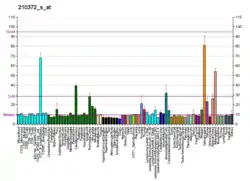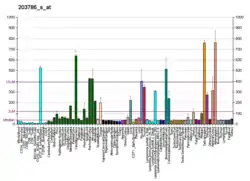TPD52L1
Tumor protein D52 is a protein that in humans is encoded by the TPD52L1 gene.[5][6][7]
Function
This gene encodes a member of the tumor protein D52 (TPD52) family. The encoded protein contains a coiled-coil domain and may form homo- or hetero-dimer with TPD52 family members. The protein is reported to be involved in cell proliferation and calcium signaling. It also interacts with the mitogen-activated protein kinase kinase kinase 5 (MAP3K5/ASK1) and positively regulates MAP3K5-induced apoptosis. Multiple alternatively spliced transcript variants have been observed, but the full-length nature of some variants has not yet been determined.[7]
References
- GRCh38: Ensembl release 89: ENSG00000111907 - Ensembl, May 2017
- GRCm38: Ensembl release 89: ENSMUSG00000000296 - Ensembl, May 2017
- "Human PubMed Reference:". National Center for Biotechnology Information, U.S. National Library of Medicine.
- "Mouse PubMed Reference:". National Center for Biotechnology Information, U.S. National Library of Medicine.
- Byrne JA, Mattei MG, Basset P (Dec 1996). "Definition of the tumor protein D52 (TPD52) gene family through cloning of D52 homologues in human (hD53) and mouse (mD52)". Genomics. 35 (3): 523–532. doi:10.1006/geno.1996.0393. PMID 8812487.
- Boutros R, Byrne JA (Oct 2005). "D53 (TPD52L1) is a cell cycle-regulated protein maximally expressed at the G2-M transition in breast cancer cells". Exp. Cell Res. 310 (1): 152–165. doi:10.1016/j.yexcr.2005.07.009. PMID 16112108.
- "Entrez Gene: TPD52L1 tumor protein D52-like 1".
- Byrne JA, Nourse CR, Basset P, Gunning P (Feb 1998). "Identification of homo- and heteromeric interactions between members of the breast carcinoma-associated D52 protein family using the yeast two-hybrid system". Oncogene. 16 (7): 873–881. doi:10.1038/sj.onc.1201604. PMID 9484778.
Further reading
- Byrne JA, Tomasetto C, Garnier JM, Rouyer N, Mattei MG, Bellocq JP, Rio MC, Basset P (1995). "A screening method to identify genes commonly overexpressed in carcinomas and the identification of a novel complementary DNA sequence". Cancer Res. 55 (13): 2896–2903. PMID 7796418.
- Byrne JA, Nourse CR, Basset P, Gunning P (1998). "Identification of homo- and heteromeric interactions between members of the breast carcinoma-associated D52 protein family using the yeast two-hybrid system". Oncogene. 16 (7): 873–881. doi:10.1038/sj.onc.1201604. PMID 9484778.
- Byrne JA, Mattei MG, Basset P, Gunning P (1998). "Identification and in situ hybridization mapping of a mouse Tpd52l1 (D53) orthologue to chromosome 10A4-B2". Cytogenet. Cell Genet. 81 (3–4): 199–201. doi:10.1159/000015029. PMID 9730602. S2CID 46742110.
- Wilson SH, Bailey AM, Nourse CR, Mattei MG, Byrne JA (2001). "Identification of MAL2, a novel member of the mal proteolipid family, though interactions with TPD52-like proteins in the yeast two-hybrid system". Genomics. 76 (1–3): 81–88. doi:10.1006/geno.2001.6610. PMID 11549320.
- Sathasivam P, Bailey AM, Crossley M, Byrne JA (2001). "The role of the coiled-coil motif in interactions mediated by TPD52". Biochem. Biophys. Res. Commun. 288 (1): 56–61. doi:10.1006/bbrc.2001.5721. PMID 11594751.
- Boutros R, Bailey AM, Wilson SH, Byrne JA (2003). "Alternative splicing as a mechanism for regulating 14-3-3 binding: interactions between hD53 (TPD52L1) and 14-3-3 proteins". J. Mol. Biol. 332 (3): 675–687. doi:10.1016/S0022-2836(03)00944-6. PMID 12963375.
- Cho S, Ko HM, Kim JM, Lee JA, Park JE, Jang MS, Park SG, Lee DH, Ryu SE, Park BC (2004). "Positive regulation of apoptosis signal-regulating kinase 1 by hD53L1". J. Biol. Chem. 279 (16): 16050–16056. doi:10.1074/jbc.M305758200. PMID 14761963.
- Rual JF, Venkatesan K, Hao T, Hirozane-Kishikawa T, Dricot A, Li N, Berriz GF, Gibbons FD, Dreze M, Ayivi-Guedehoussou N, Klitgord N, Simon C, Boxem M, Milstein S, Rosenberg J, Goldberg DS, Zhang LV, Wong SL, Franklin G, Li S, Albala JS, Lim J, Fraughton C, Llamosas E, Cevik S, Bex C, Lamesch P, Sikorski RS, Vandenhaute J, Zoghbi HY, Smolyar A, Bosak S, Sequerra R, Doucette-Stamm L, Cusick ME, Hill DE, Roth FP, Vidal M (2005). "Towards a proteome-scale map of the human protein-protein interaction network". Nature. 437 (7062): 1173–1178. Bibcode:2005Natur.437.1173R. doi:10.1038/nature04209. PMID 16189514. S2CID 4427026.
- Barbaric D, Byth K, Dalla-Pozza L, Byrne JA (2006). "Expression of tumor protein D52-like genes in childhood leukemia at diagnosis: clinical and sample considerations". Leuk. Res. 30 (11): 1355–1363. doi:10.1016/j.leukres.2006.03.009. PMID 16620967.
- Cao Q, Chen J, Zhu L, Liu Y, Zhou Z, Sha J, Wang S, Li J (2006). "A testis-specific and testis developmentally regulated tumor protein D52 (TPD52)-like protein TPD52L3/hD55 interacts with TPD52 family proteins". Biochem. Biophys. Res. Commun. 344 (3): 798–806. doi:10.1016/j.bbrc.2006.03.208. PMID 16631610.
This article is issued from Wikipedia. The text is licensed under Creative Commons - Attribution - Sharealike. Additional terms may apply for the media files.





